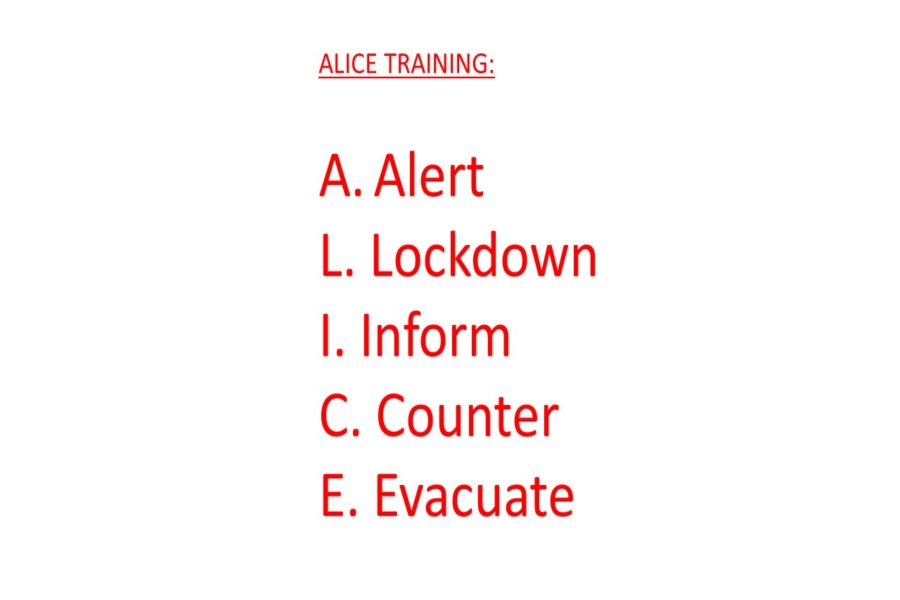Students, staff believe ALICE program steps in right direction
IMAGE / Cassie Horne
ALICE training better prepares students and teachers for possible violent events.
Schools once used unsafe methods for dealing with school bombing and shooting threats.
These policies left students feeling vulnerable to any possibility of a threat in their own school district.
Previously, schools would deal with the threats by keeping students locked in the classrooms without going out an exit and having them huddle in a corner or hide under desks.
But now Kearsley uses the Alert, Lockdown, Inform, Counter, and Evacuate program, which greatly improves the way schools train to deal with such terrifying events.
Kearsley began ALICE training in the beginning of the 2018-2019 school year.
With ALICE, there are more options to deal with a threat, and teachers are equipped to deal with any situation.

Mrs. Marti VanOverbeke, English teacher, believes that ALICE training is a better policy than just sheltering in place.
Mrs. Marti VanOverbeke, English teacher, takes things seriously if it means keeping her students safe.
“I definitely feel that this type of training is an improvement on the old policy of shelter-in-place,” VanOverbeke said. “This new training allows teachers to adapt to the circumstances in order to keep their students safe.”
VanOverbeke isn’t completely confident with this new type of training, but feels readier for a situation.
“I am not certain that I feel safer, but I do feel better prepared for the worst-case scenario,” VanOverbeke said. “The training was eye-opening and truly helped us better understand the statistics behind ALICE training.”
ALICE educates teachers and students on how to protect themselves and others in a dangerous situation.
The training is meant to lead to a solution that increases an organization’s and individual’s odds of survival during a violent intruder event, according to the ALICE website.
ALICE gives teachers and students a bigger advantage of staying safe during a violent threat by allowing students and teachers to fight back and better deal with a potentially dangerous situation.
Teachers now attempt to get students out of the school, if possible, instead of keeping them hidden somewhere in the classroom.
Staff members could try to get students out of the building by breaking a window, for instance, and then making sure it’s safe to run away.
Students are told to run with their hands above their heads so that the police know they’re not a threat.
Freshman Victor Desjardins likes the new way of training.
“Honestly, I’m glad that I can protect myself if I absolutely had to,” Desjardins said. “I hated sitting around in the classroom, not knowing exactly what was going on.”
Desjardins said that it’s safer for students to fight back but not the safest option overall.
“I think it’s safer,” Desjardins said. “But it’s definitely not the safest because the chances of every single student surviving is almost impossible if an attack was to come to our school, so it’s really not that safe.”
Many students remember having to hide in a corner or even under desks for a lockdown or drill.
Some students think it was scary to know that if a violent person was to break into a classroom, every student hiding was vulnerable to attack.
Students feel better knowing that the old method of hiding and hoping is not the only option.
Sophomore LillyAnne Crews feels the odds of surviving a possible life-threatening event are a lot higher than before.
“I honestly feel that ALICE training is a lot safer than how it used to be,” Crews said. “I appreciate that they had changed it from hiding in corners, under desks, and staying in the classroom to more of a fighting back way.”
Crews believes the plan could still be improved.
“It can still use quite a bit of improvement and more things to add to it,” Crews said. “But at least we aren’t staying in a classroom unable to protect ourselves in any way.”

Birthday: Dec. 18, 2002
Hobbies/Interests: Cheer, and hanging out with friends.
Favorite Quote: "That's always seemed so ridiculous to me,...






